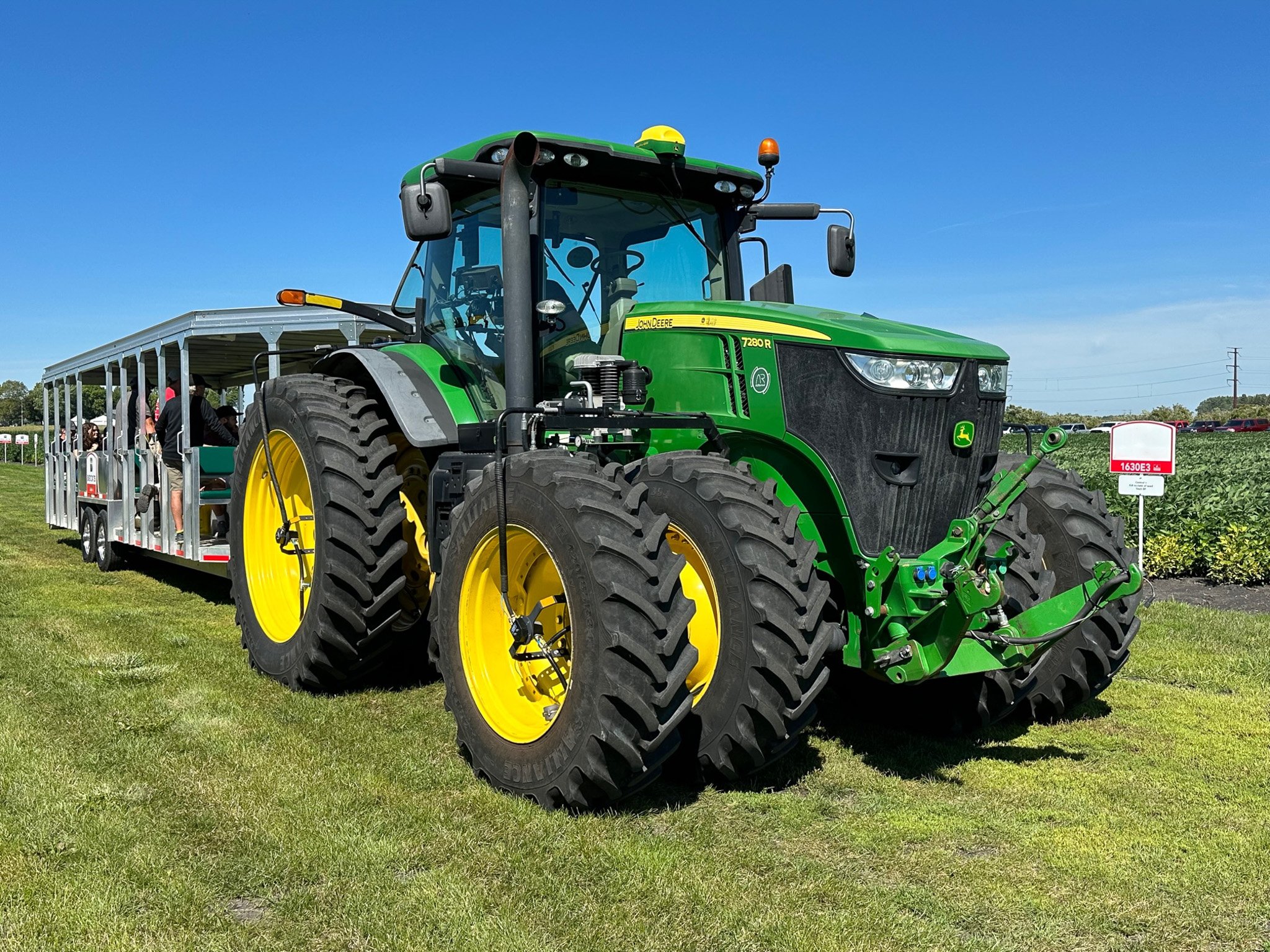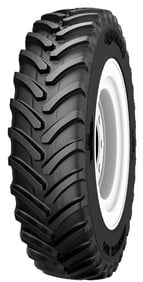Spotlighting the Power of Proper Inflation Pressure and VF Tires
Innovative tire technologies like very high flexion (VF) help farmers do everything from reducing soil compaction to boosting yields. To maximize the advantage offered by VF tires, it’s important to operate them at the lowest safe air pressure for the field based on load and speed. Recently, Yokohama Off-Highway Tires America supported a demonstration by NTS Tire Supply and AgRevival to highlight the powerful opportunity that the right tires, set at the right pressure, present to farmers.
 The Test
The Test
 To highlight the impact VF tires and air pressure have on the farm, we headed to the AgRevival Research Farm in Gibbon, Minnesota. NTS Tire Supply outfitted AgRevival’s 1,000-gallon Hagie 2101 sprayer with VF380/85R30 Alliance Agriflex+ 354 tires which were driven across AgRevial’s test field at two different tire pressures: 35 psi and 17 psi.
To highlight the impact VF tires and air pressure have on the farm, we headed to the AgRevival Research Farm in Gibbon, Minnesota. NTS Tire Supply outfitted AgRevival’s 1,000-gallon Hagie 2101 sprayer with VF380/85R30 Alliance Agriflex+ 354 tires which were driven across AgRevial’s test field at two different tire pressures: 35 psi and 17 psi.
Carrying a load of 5,000 pounds on each tire, a pressure of 17 psi is an optimal inflation pressure for these tires, on this sprayer, in the field. However, farmers often operate their tires overinflated and a high pressure of 35 psi was chosen for the test. It’s common for farmers to run their tires at the maximum inflation pressure printed on the sidewall.
Footprint
Before hitting the field, the difference between the tires inflated to high pressure and tires inflated to low pressure was noticeable. The tires inflated to 17 psi produced a significantly longer footprint, which, in the field spreads the weight of the heavy Hagie sprayer over a larger area. The tires inflated to 17 psi provided a visibly larger footprint—in fact, their contact patch was 33% larger than that of the tires inflated to 35 psi.
Three Soil Health Tests
The test set out to spotlight how the correct tire operating at the proper pressure influences soil health through three demonstrations:
- Rut depth
- Water infiltration
- Soil compaction
Rut Depth
Rut depth is a physical sign of tire performance: the shallower the tracks, the better. Here again, the advantage provided by the tires inflated to an ideal pressure was noticeable to the naked eye. The tires inflated to a higher pressure left behind a deeper track and the space between the lugs was firmer—this indicates the higher pressure tire was applying more pressure to the soil. Conversely, the tires operating at lower pressures left behind a shallower track and barely compacted the ground between the lugs.
Digging out the tape measure confirmed what was plainly visible. The overinflated tire produced ruts measuring 3.5 inches deep while the optimally inflated tires left behind tracks just 2.5 inches deep. Sinking further in the soil has many drawbacks, including causing compaction, increasing the potential for erosion, and hurting fuel efficiency.
Soil Compaction
Most farmers are aware of the numerous issues caused by soil compaction but don’t know that having properly inflated tires is one of the best ways to keep this menace out of their fields. After measuring the ruts in the experiment above, a penetrometer was used to see how much compaction the tires caused by a single pass across the field.
Over 300 psi was required to push through the compaction layer of the tracks (at 5.25 inches deep) made by the tires operating at 35 psi. In comparison, 16% less force on the penetrometer was needed to push through the compaction layer (at only 4 inches deep) of the tracks running at 17 psi. A less dense compaction layer closer to the surface is easier to address with tillage or, in many areas, seasonal swelling and contraction in the soil.
As AgRevival’s Chief Agronomist, Nate Firle, reminds us, “80% of the compaction is done in the first pass. One pass can do a lot of damage.”
Water Infiltration
In compacted soil, soil particles are pushed tightly together and the air between the particles is reduced. This limits water's ability to move from the surface to the root zone. To demonstrate how tire pressure influences water infiltration, two eight-inch-long PVC pipes were driven into the visible tracks—one in the tracks of the tires run at a high pressure and one in those made by the tires opening at an ideal pressure. The equivalent of a 3-inch rain event was then simulated by filling each pipe with 32 ounces of water.
Once again, the difference between the two tracks was readily apparent. A little over 5 minutes into the test, the water in the 17 psi track was down to under an inch and bubbling—a sign that the soil was still allowing water to infiltrate. At this point, the pipe in the 35 psi track still contained about 1.5 inches of water, which had stopped bubbling. Roughly 15 minutes later, the water level in the pipe in the optimal pressure track was under 0.75 inches and the water level in the overinflated tracks had only dropped to 1.25 inches.
In your field, this can mean the difference between water pooling up in your tracks and probably running off your field, or getting into the ground where it can do good.
See For Yourself
Seeing is believing. Check out this excellent video from NTS Tire Supply showing the tests and the impressive results produced by our VF380/85R30 Agriflex+ 354 radial tires when inflated to the optimal pressure.
Other Ag Innovations
While high-tech VF tires can unlock your farm’s potential, other innovative technologies are helping farmers make the most out of their investment in cutting-edge tire technology. For example, central tire inflation systems (CTIS) allow farmers to adjust tire inflation in mere minutes at the push of a button and easily adjust their tires’ psi from road-friendly high pressures to field-friendly low pressures without ever having to leave the cab. CTIS is especially beneficial for equipment that spends a lot of time on the road traveling between fields.
Alliance Whole Farm Concept
Another way to maximize your investment in VF tires is by ensuring every piece of equipment that enters your field is equipped with a tire able to operate at low pressure. After all, the benefit of running a VF-equipped sprayer in the spring is quickly neutralized by running a combine on conventional tires in the fall.
Alliance’s Whole Farm concept is our commitment to delivering a low-pressure tire for every piece of equipment that enters the field—allowing farmers to work in the field without worrying about damaging their most precious resource, their soil. Contact your local Yokohama Off-Highway Tires dealer or rep to learn more about our industry-leading line of steel-belted Alliance Agriflex/Agriflex+ IF/VF tires and how they can help your farm.
Alliance Whole Farm Concept
Yokohama Off-Highway Tires’ Alliance brand believes in the power of low-pressure tires and is committed to offering a low-pressure tire for every piece of equipment that enters the field. The benefits of Alliance Agriflex+ VF tires include:
- 10-year warranty: a testament to Alliance’s commitment to delivering high-quality, long-lasting tires
- Steel-belted construction: protects against punctures and enables tires to produce a large, even footprint
- Special compounds: formulated to enhance durability and extend service life
- Versatility: innovative tread patterns and premium construction enable tires to offer high performance in the field and on the road
- D Speed Rating: capable of traveling at speeds up to 40 mph

